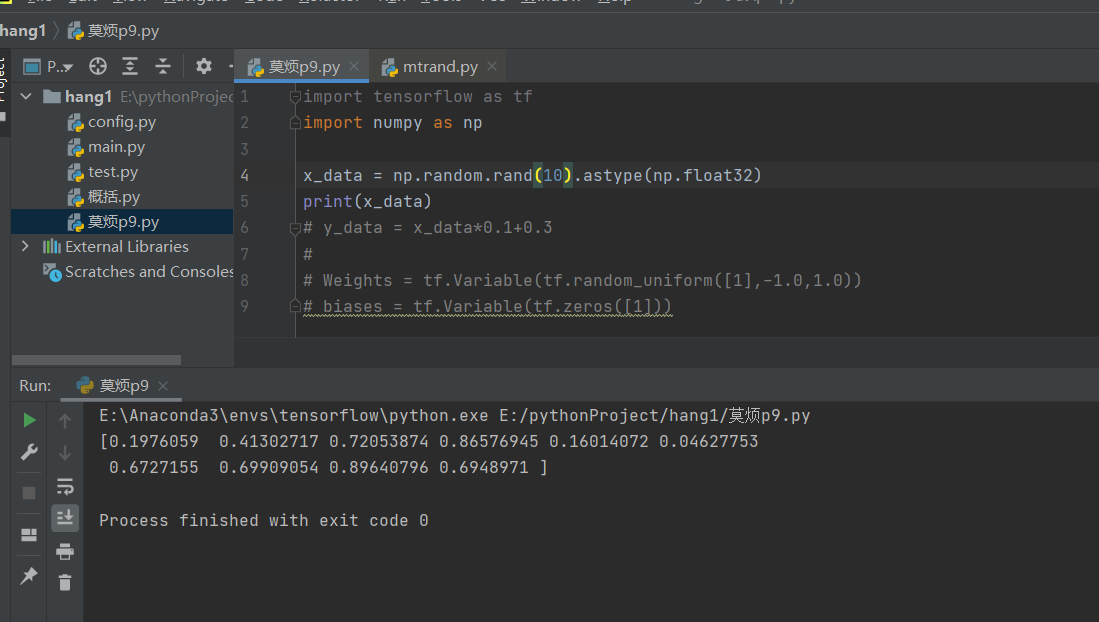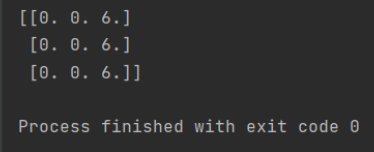我是靠谱客的博主 专注柚子,这篇文章主要介绍np.random.rand/newaxis/tf.multiply与tf.matmul的区别/tf.reduce_sum()函数和tf.reduce_mean()函数np.random.rand(d0,d1,d2……dn)newaxistf.multiply与tf.matmul的区别tf.reduce_sum()函数和tf.reduce_mean()函数Reference,现在分享给大家,希望可以做个参考。
np.random.rand(d0,d1,d2……dn)
- 通过本函数可以返回一个或一组服从“0~1”均匀分布的随机样本值。随机样本取值范围是[0,1),不包括1。
1)当函数括号内没有参数时,则返回一个浮点数;
2)当函数括号内有一个参数时,则返回秩为1的数组,不能表示向量和矩阵;
3)当函数括号内有两个及以上参数时,则返回对应维度的数组,能表示向量或矩阵;


newaxis
运行如下代码:

- 由以上代码可以看出,以前的shape是3
- 把newaxis放后面的时候,输出的新数组的shape就是3××1,也就是后面增加了一个维数newaxis
- 把newaxis放在前面的时候变成了1××3,也就是前面的维数增加了一个
- newaxis放在第几个位置,就会在shape里面看到相应的位置增加了一个维数
tf.multiply与tf.matmul的区别
- tf.multiply()可用作两个矩阵中对应元素各自相乘等
- tf.matmul()将矩阵a乘以矩阵b,生成a * b
- tf.multiply不一定是逐个元素对应相乘,也可能是利用广播特性。
tf.multiply()
import tensorflow as tf
#两个矩阵的对应元素各自相乘!!
x=tf.constant([[1.0,2.0,3.0],[1.0,2.0,3.0],[1.0,2.0,3.0]])
y=tf.constant([[0,0,1.0],[0,0,1.0],[0,0,1.0]])
#注意这里这里x,y要有相同的数据类型,不然就会因为数据类型不匹配而出错
z=tf.multiply(x,y)
#两个数相乘
x1=tf.constant(1)
y1=tf.constant(2)
#注意这里这里x1,y1要有相同的数据类型,不然就会因为数据类型不匹配而出错
z1=tf.multiply(x1,y1)
#数和矩阵相乘
x2=tf.constant([[1.0,2.0,3.0],[1.0,2.0,3.0],[1.0,2.0,3.0]])
y2=tf.constant(2.0)
#注意这里这里x1,y1要有相同的数据类型,不然就会因为数据类型不匹配而出错
z2=tf.multiply(x2,y2)
with tf.Session() as sess:
print(sess.run(z))
print(sess.run(z1))
print(sess.run(z2))

tf.matmul()
#两个矩阵相乘
x3=tf.constant([[1.0,2.0,3.0],[1.0,2.0,3.0],[1.0,2.0,3.0]])
y3=tf.constant([[0,0,1.0],[0,0,1.0],[0,0,1.0]])
#注意这里这里x,y要满足矩阵相乘的格式要求。
z3=tf.matmul(x,y)
with tf.Session() as sess:
print(sess.run(z3))

tf.reduce_sum()函数和tf.reduce_mean()函数
- tf.reduce_sum()
tf.reduce_sum
matrix1 = [[1.,2.,3.], #二维,元素为列表
[4.,5.,6.]]
matrix2 = [[[1.,2.],[3.,4.]], #三维,元素为矩阵
[[5.,6.],[7.,8.]]]
res_2 = tf.reduce_sum(matrix1)
res_3 = tf.reduce_sum(matrix2)
res1_2 = tf.reduce_sum(matrix1,reduction_indices=[0])
res1_3 = tf.reduce_sum(matrix2,reduction_indices=[0])
res2_2 = tf.reduce_sum(matrix1,reduction_indices=[1])
res2_3 = tf.reduce_sum(matrix2,reduction_indices=[1])
sess = tf.Session()
print("reduction_indices=None:res_2={},res_3={}".format(sess.run(res_2),sess.run(res_3)))
print("reduction_indices=[0]:res1_2={},res1_3={}".format(sess.run(res1_2),sess.run(res1_3)))
print("reduction_indices=[1]:res2_2={},res2_3={}".format(sess.run(res2_2),sess.run(res2_3)))
result:
axis=None:res_2=21.0,res_3=36.0
axis=[0]:res1_2=[5. 7. 9.],res1_3=[[ 6. 8.]
[10. 12.]]
axis=[1]:res2_2=[ 6. 15.],res2_3=[[ 4. 6.]
[12. 14.]]
- tf.reduce_mean
只需要把上面代码的reduce_sum部分换成renduce_mean即可
res_2 = tf.reduce_mean(matrix1)
res_3 = tf.reduce_mean(matrix2)
res1_2 = tf.reduce_mean(matrix1,axis=[0])
res1_3 = tf.reduce_mean(matrix2,axis=[0])
res2_2 = tf.reduce_mean(matrix1,axis=[1])
res2_3 = tf.reduce_mean(matrix2,axis=[1])
result:
axis=None:res_2=3.5,res_3=4.5
axis=[0]:res1_2=[2.5 3.5 4.5],res1_3=[[3. 4.]
[5. 6.]]
axis=[1]:res2_2=[2. 5.],res2_3=[[2. 3.]
[6. 7.]]
可以看到,reduction_indices和axis其实都是代表维度,当为None时,reduce_sum和reduce_mean对所有元素进行操作,当为[0]时,其实就是按行操作,当为[1]时,就是按列操作,对于三维情况,把最里面的括号当成是一个数,这样就可以用二维的情况代替,最后得到的结果都是在原来的基础上降一维,
Reference
1.终于弄懂tf.reduce_sum()函数和tf.reduce_mean()函数
2.tf.multiply与tf.matmul的区别
3.Numpy学习—np.random.randn()、np.random.rand()和np.random.randint()
最后
以上就是专注柚子最近收集整理的关于np.random.rand/newaxis/tf.multiply与tf.matmul的区别/tf.reduce_sum()函数和tf.reduce_mean()函数np.random.rand(d0,d1,d2……dn)newaxistf.multiply与tf.matmul的区别tf.reduce_sum()函数和tf.reduce_mean()函数Reference的全部内容,更多相关np.random.rand/newaxis/tf.multiply与tf.matmul内容请搜索靠谱客的其他文章。
本图文内容来源于网友提供,作为学习参考使用,或来自网络收集整理,版权属于原作者所有。








发表评论 取消回复